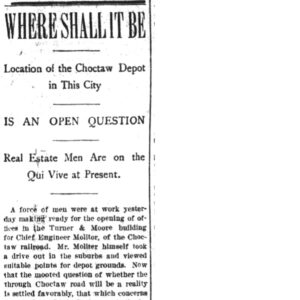calsfoundation@cals.org
Choctaw Freight Terminal
The Choctaw Freight Terminal served the Choctaw and Memphis Railroad Company (originally the Memphis and Little Rock Railroad) as a hub for the transportation of goods to and from Little Rock (Pulaski County). Located in the eastern part of the city, it was covered over by a superstructure in the 1960s and then razed in 2001 to make way for the construction of the William J. Clinton Presidential Center and Park. At the time of its demolition, it was the last surviving example of a traditional two-story brick freight station in Arkansas.
When the Choctaw and Memphis Railroad Company began freight and passenger service from Little Rock to Memphis, Tennessee, in 1899, a depot for passengers stood on the Little Rock side of the Arkansas River, but the freight depot was at the former yard in North Little Rock (Pulaski County). On October 28, 1899, C. W. Clark of Malvern (Hot Spring County) got the contract to build the freight station on the south side of the river. Chief Engineer F. A. Molitor had selected future Arkansas governor George Washington Donaghey to design a section house near Shawnee, Oklahoma. Molitor was so pleased with Donaghey’s work that he made him a subcontractor for the construction of many of the structures, water tanks, and bridges along the Choctaw, Oklahoma and Gulf Railroad (as the railroad was later renamed). This included the Choctaw Freight Terminal in Little Rock.
The Choctaw terminal was the “flagship” station for the railroad and an important regional railroad headquarters in Little Rock. The freight terminal—positioned on a north-south axis with a long, covered loading area on the east side and a smaller covered loading area on the west—dominated the landscape. The building was a rectilinear plan, approximately forty feet by 215 feet. This turn-of-the-century railroad depot was said to be a fine example of railroad architecture due to its interior beams (massive timbers more common to railroad truss bridges) and distinctive brick work, including Gothic arches and Florentine patterns over the doorways and windows. Many of the bricklayers and stone masons were former slaves who hand-trimmed the wedge-shaped bricks of various sizes for the many arches over the entrances.
Freight traffic began at the new building on April 9, 1900. This was facilitated by the completion of the bridge now known as the Rock Island Bridge across the Arkansas River in December 1899. This joined the railroad freight yard to the new Choctaw freight terminal building and freight yard. This bridge connected both sides of the Arkansas River and ensured the success of the Choctaw, Oklahoma, and Gulf Railroad.
The Choctaw freight terminal was on East Second Street just east of the Choctaw passenger station and the Choctaw general offices (the former Alexander George house). The Choctaw also maintained a separate downtown ticket office at 102 ½ West Markham. The local officers were H. E. Yarnall; J. W. McLoud, general solicitor; J. M. Moore, counsel; Sidney J. Hayden, auditor; Henry Wood, general manager; F. A. Molitor, chief engineer; H. H. Harris, general superintendent; S. H. Barnes, trainmaster; James F. Holden; H. W. Morrison, general freight agent; and Charles H. Welsh, master mechanic.
In 1911, the railroad opened a larger freight station in Little Rock, and for the next fifty years, the building was leased to a variety of businesses and used as a warehouse or for equipment storage. In 1962, the May Supply Company, which had purchased the building the previous year, added a superstructure over the freight depot to meet the company’s expanding need for space. This structure provided a cocoon that helped preserve the old freight station from the elements. Hidden away, the station was soon forgotten, coming to the attention of preservationists again only in 2001, when the construction of the William J. Clinton Presidential Center and Park threatened the historic structure. Preservationists across the country, including the National Trust for Historic Preservation, tried to convince officials with the City of Little Rock and the Clinton Library Foundation to alter their plans and save the structure. However, on November 21, 2001, the station was demolished.
The red-brick passenger terminal still stands on the grounds of the William J. Clinton Presidential Center and Park. It is used as office and classroom space by the Clinton Foundation and the Clinton School of Public Service.
For additional information:
“Choctaw Terminal.” Trainweb.org. http://www.trainweb.org/choctawterminal/ (accessed November 8, 2021).
Crouch, Elisa. “1899 Depot Razed by Time Judge Gets Filing to Save It.” Arkansas Democrat-Gazette, November 22, 2001, pp. 1A, 23A.
“Little Rock Train Station May Be Railroaded for Clinton Library.” Preservation. http://www.preservationnation.org/magazine/911/little-rock-train-station-may.html (accessed November 8, 2021).
Shue, Jerry L., Sr. “A Little Choctaw (Railroad) History.” Pulaski County Historical Review 61 (Fall 2013): 89–91.
Jerry L. Shue Sr.
North Little Rock, Arkansas
 Post-Reconstruction through the Gilded Age, 1875 through 1900
Post-Reconstruction through the Gilded Age, 1875 through 1900 Choctaw Freight Terminal Article
Choctaw Freight Terminal Article 




Comments
No comments on this entry yet.